Laravel
This tutorial is aimed at developers already familiar with Laravel who are interested in creating a mobile app using Draftbit. We'll walk through how to setup Laravel to provide authentication endpoints and then setup a login and home screen in Draftbit.
Getting Laravel Ready
For the purpose of this tutorial I will assume you already have a Laravel application setup. The only dependency requirement is the official Laravel Sanctum package which provides a token-based authentication system for SPAs, APIs, and mobile apps. If you are using Laravel Jetstream, then you already have Sanctum installed and ready to go!
We're also going to use Expose (free) in order to reach our local machine from Draftbit and the mobile app during development.
Authentication routes
We need to add two routes in our application - one to issue a device token and another to revoke a token. These endpoints can be whatever you like. Below I have added them to the default api routes file.
// routes/api.php
// generate new token and respond with user
Route::post('auth/token', [AuthController::class, 'login'])->name('api.login');
// authenticated routes
Route::middleware('auth:sanctum')->group(function () {
// revoke user device token
Route::delete('auth/token', [AuthController::class, 'logout'])->name('api.logout');
});Remember that Laravel automatically adds
/apito the URL for routes in the defaultroutes/api.phpfile
Authentication controller
Next we need to handle the incoming request. For this I have created a new AuthController file, but of course you can put this logic anywhere you like.
Although it's possible to authenticate with any user configuration, I will assume in this tutorial that you have the default User model with name, email, and password attributes.
Handling requests to the login route
Sanctum requires the user's email, password, and a device name to associate with the issued token. If the user is successfully authenticated, then we create a new device token for the user and return it along with the basic user data.
// app/Http/Controllers/Api/AuthController.php
public function login(Request $request)
{
// validate the request
$request->validate([
'email' => ['required', 'email'],
'password' => 'required',
'device_name' => 'required',
]);
// lookup the user
$user = User::where('email', $request->email)->first();
// throw an error if the user doesn't exist
if (! $user) throw ValidationException::withMessages([
'email' => ["We couldn't find an account associated with the email you provided."],
]);
// throw an error if the password is invalid
if (! Hash::check($request->password, $user->password)) throw ValidationException::withMessages([
'password' => ['The password you entered is invalid.'],
]);
// create a new token for the user
$token = $user->createToken($request->device_name)->plainTextToken;
// return the user and token
return response()->json([
'id' => $user->id,
'name' => $user->name,
'email' => $user->email,
'token' => $token,
]);
}Handling requests to the logout route
In order to revoke a user's token, thereby logging them out of the app, the user's id and device token are required. If the request is valid then we revoke the user's device token and return a simple success message.
// app/Http/Controllers/Api/AuthController.php
public function logout(Request $request)
{
// validate the request
$request->validate([
'id' => 'required',
'device_token' => 'required',
]);
// lookup the user
$user = User::find($request->id);
// delete the given token
$user->tokens()->where('token', $request->device_token)->delete();
// return success message
return response()->json([
'message' => 'success',
]);
}That's it! This is all we need on the Laravel side. Next, let's move over to Draftbit.
Getting Draftbit Ready
Most of our work will be done here, but don't worry - Draftbit makes it a breeze!
Screens & navigation
For the purpose of this tutorial, we will have two Screens - Login and Home.
We will also have two Stack Navigators nested under our Root Navigator - AuthStack and AppStack - and move each screen under their respective stack.
And, we'll set the Root Navigator's initial route to AuthStack.

Global variables
Draftbit provides two different types of App Variables - App and Device. We'll need to set a few for each of these.
App Variables
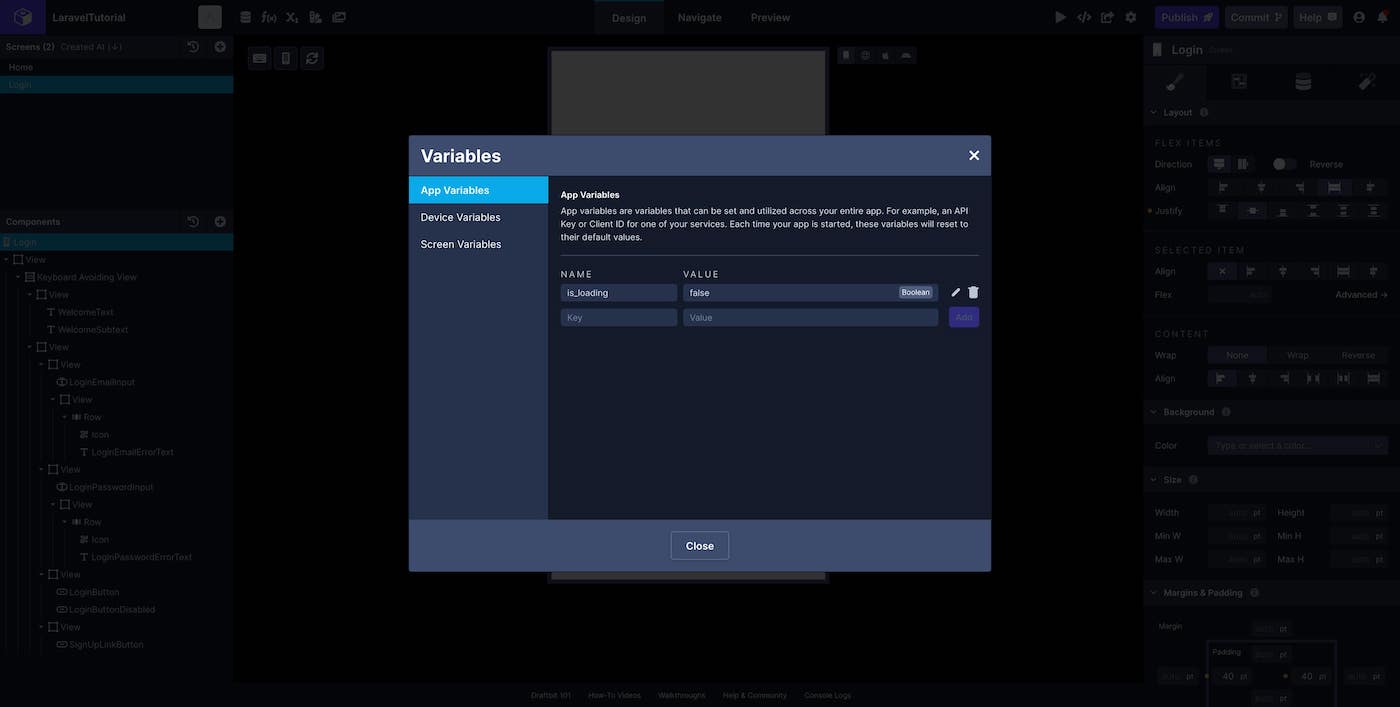
Device Variables
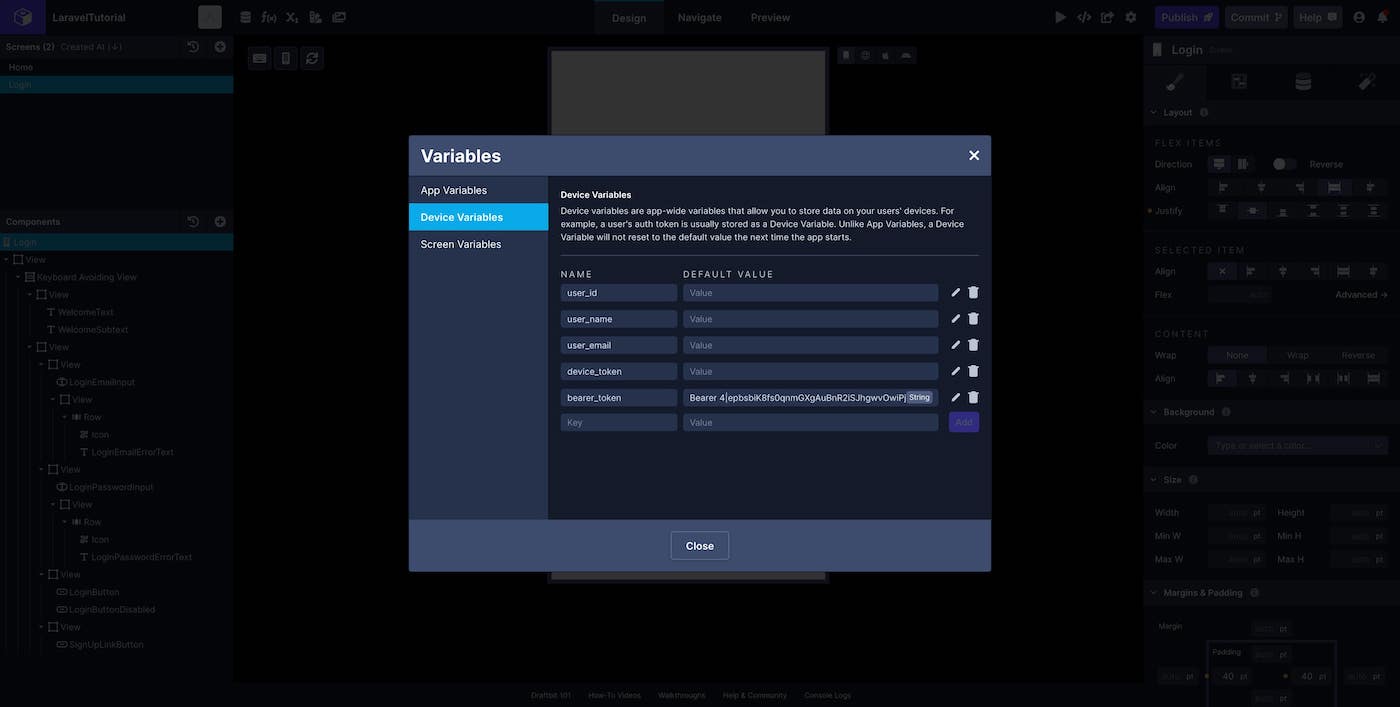
The
bearer_tokenvariable is what you'll use to make API requests on behalf of the authenticated user. You can leave it blank for now, we'll set it up later.
Custom API connection
Draftbit provides a pretty intuitive and simple way to setup custom API connections and endpoints, and that's what we're going to do now.
First thing we need to do is setup our base connection under the Data tab in Draftbit. This is where Expose comes in and you'll need to have your site accessible via an Expose share link.

Give your new API connection a name and paste your Expose share link + your API base path into the Dev URL or Prod URL field. This can vary depending on how you setup your routes earlier in Laravel.
We'll leave the default headers. Save the connection when finished.
Dev & Prod URLSThe Base URL parameter has been updated to give you the ability to set separate base URLs for Development and Production. When you publish your app, you can set which base URL to use, Dev or Prod. Read more about Environments

Each time you restart the Expose tunnel it will generate a new share link which will need to be updated in your API connection settings in Draftbit
Custom API endpoints
Next, we need to setup our Login and Logout endpoints.
Login Endpoint
Endpoint Basics
- Name:
Login - Method:
POST - Role: Leave unset
- Object Type: Leave unset
Path & Parameters
- Path:
/auth/token
(may be different depending on how you setup your routes)
Body
{
"email": {{ email }},
"password": {{ password }},
"device_name": {{ device_name }}
}For the test values, enter a valid email and password for your Laravel application and a device name.
Headers
We will keep the two default headers (Accept & Content-Type) set to application/json.
Test
Double check that your endpoint looks correct and then click the 'Test' button. When successful, you should receive a response that looks like this:
{
"id": 1,
"name": "Dave",
"email": "[email protected]",
"token": "2|fYQelzPGFviDSxtz5Q5oY54QxnzBeuRKpJPO3jNF"
}
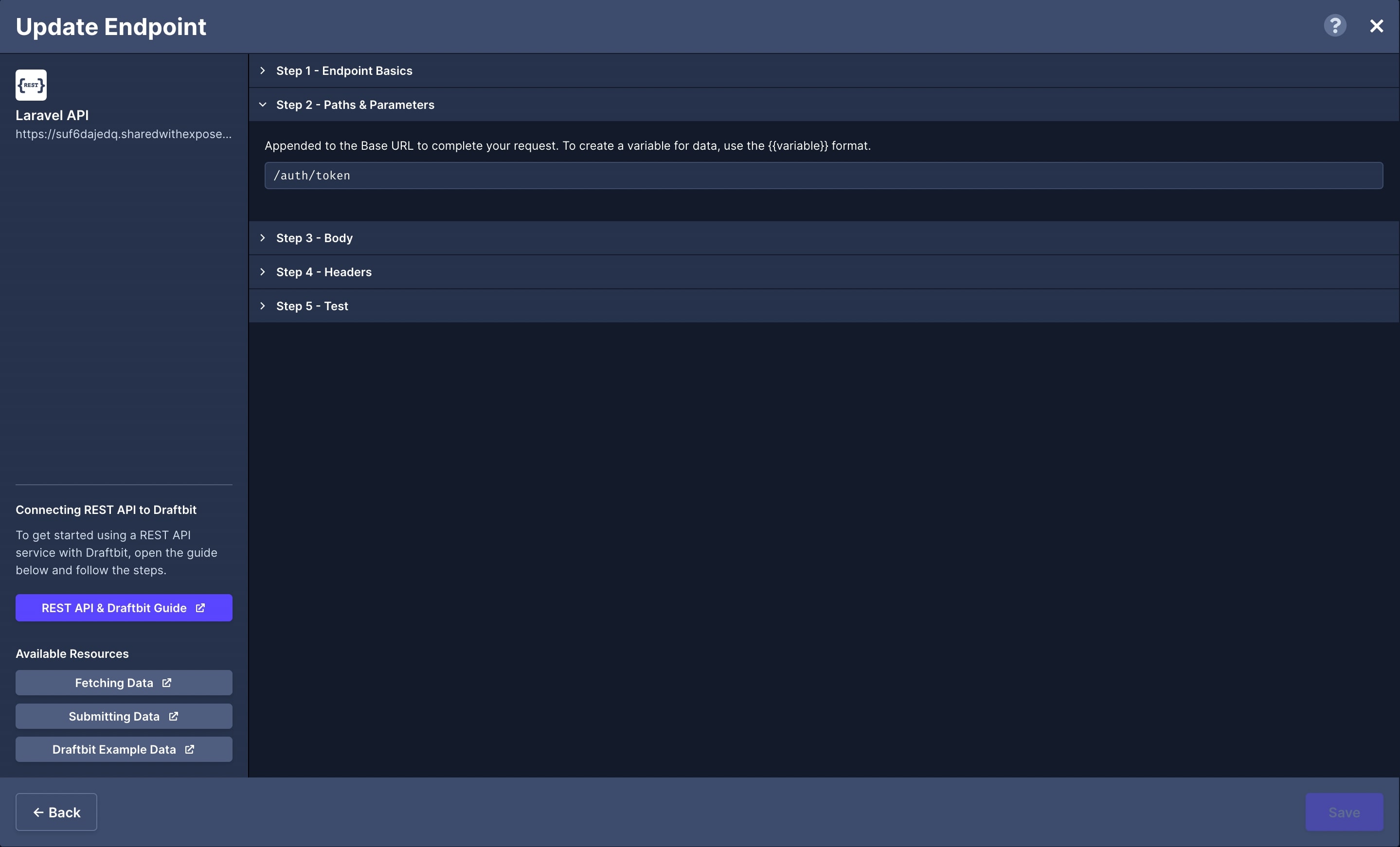
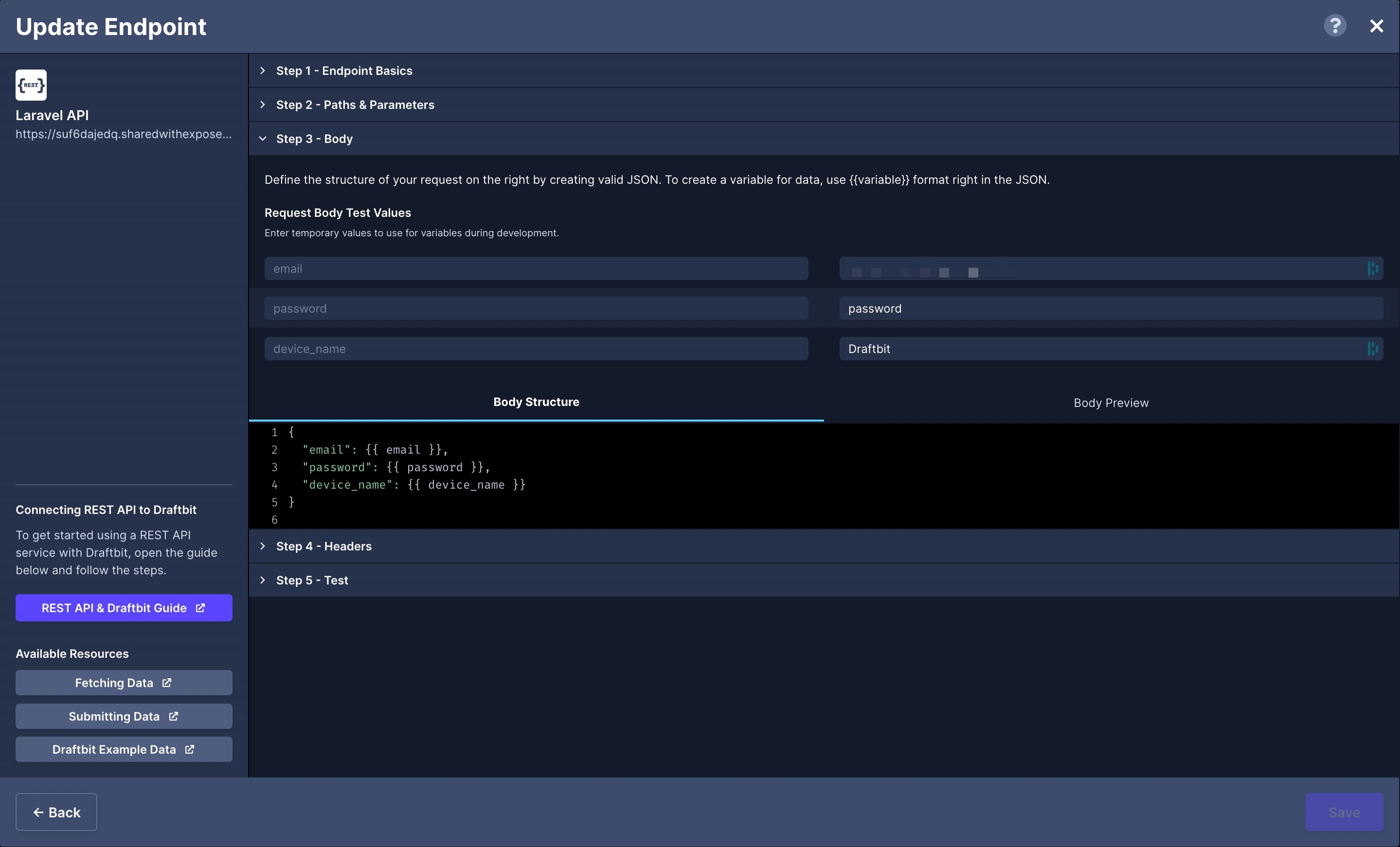
Update Device Variable
Copy the returned token, open up the Device variables, and update the default value for our bearer_token variable with the token we just received prepended with Bearer. This will allow us to test our Logout endpoint which we will configure next.

Logout Endpoint
Endpoint Basics
- Name:
Logout - Method:
DELETE - Role: Leave unset
- Object Type: Leave unset
Path & Parameters
- Path:
/auth/token
(may be different depending on how you setup your routes)
Body
{
"id": {{ id }},
"device_token": {{ device_token }}
}For the test values, enter the user id and token you received in the response from the Login Endpoint test.
Headers
Here we'll need to add an Authorization header and set the value to our bearer_token Global variable.
Test
Double check that your endpoint looks correct and then click the 'Test' button. When successful, you should receive a response that looks like this:
{
"message": "success"
}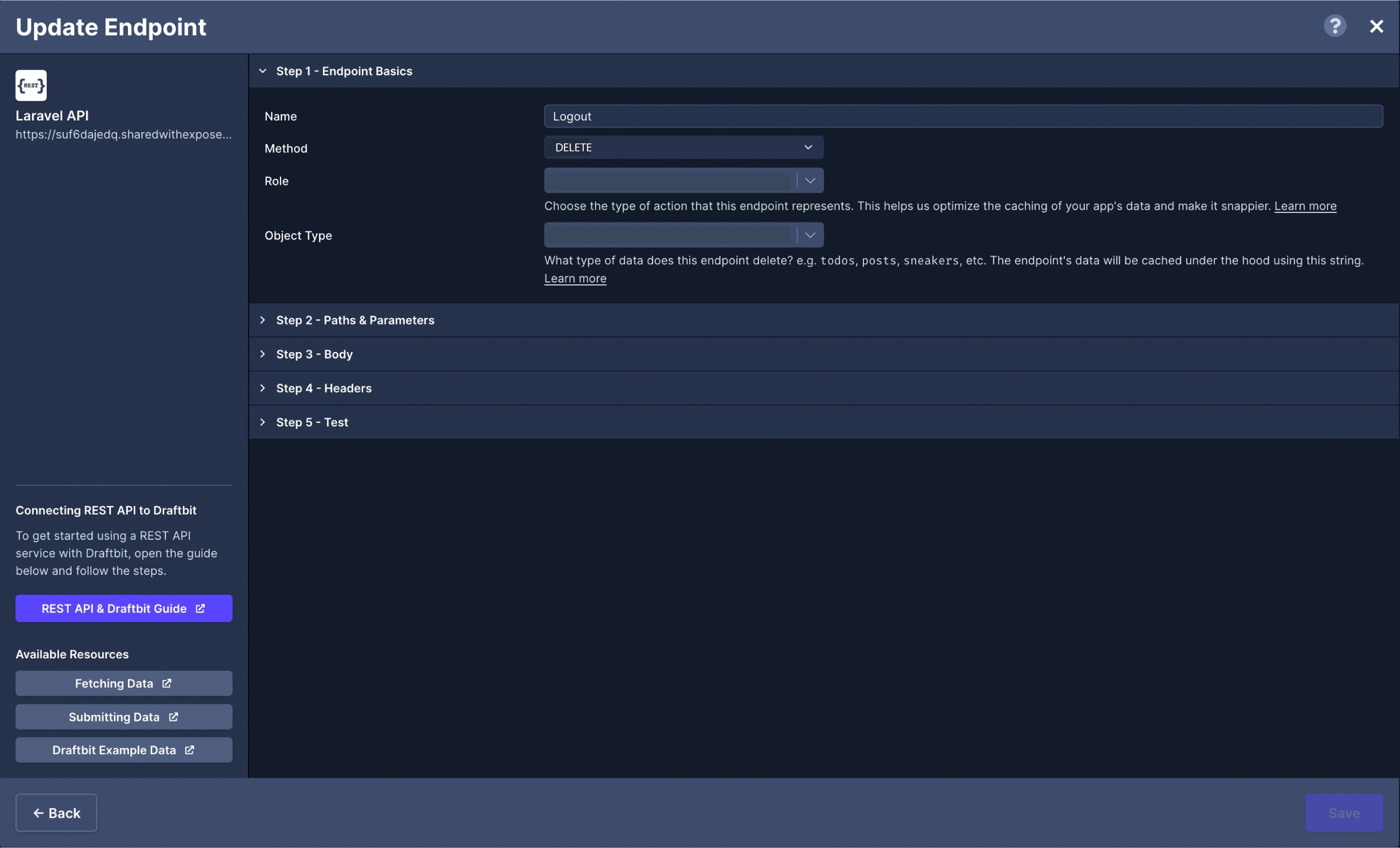
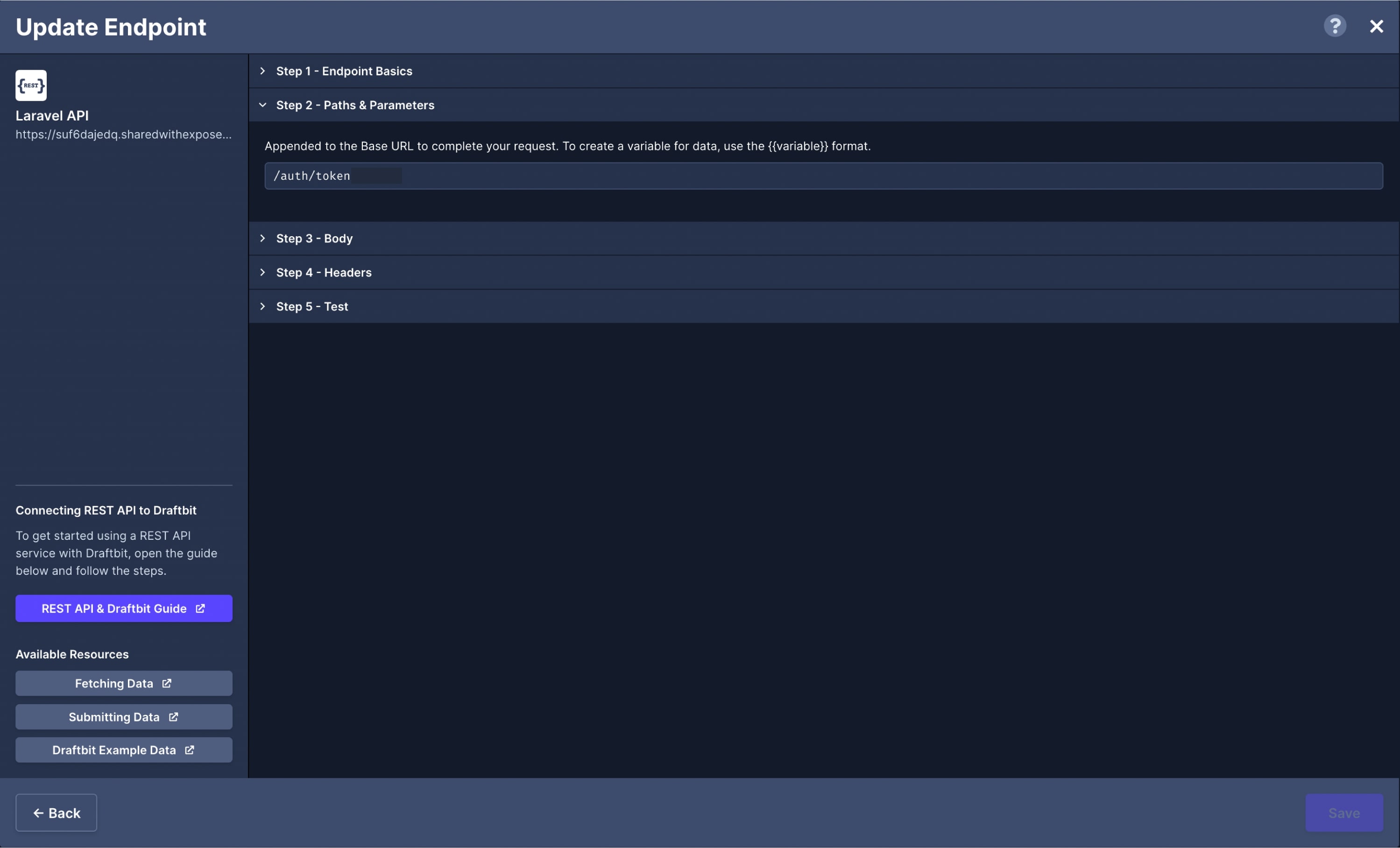
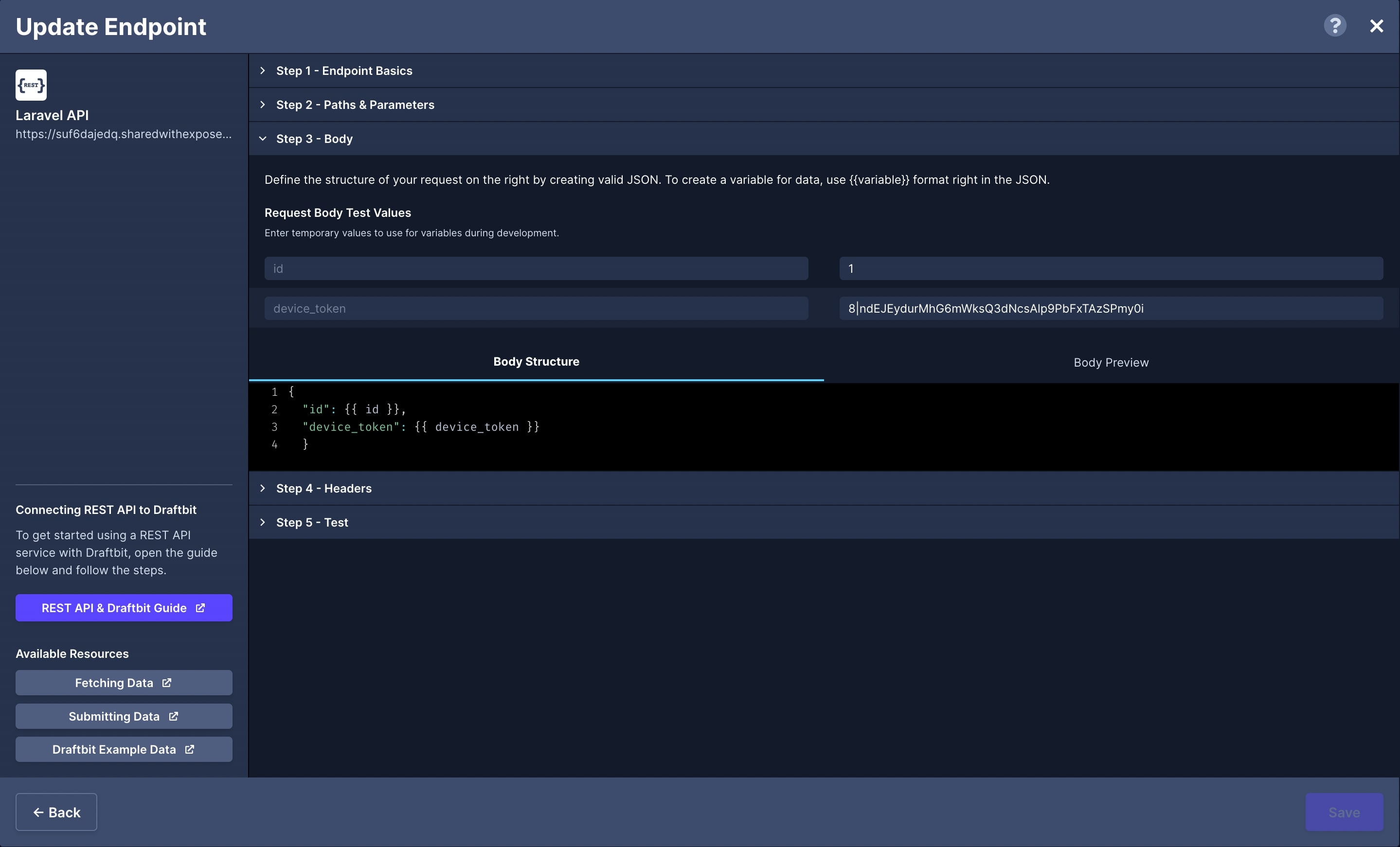
Login Screen
Making progress! Ok, so now we need to setup our Login Screen's components, custom code, and button actions.
Screen Components
We'll need at least 5 components:
- Email input
- Password input
- Email error text
- Password error text
- Login button
You can name the components and fields however you prefer. We will come back to these components later and further configure them once we have setup our custom code and actions.
Here's what mine looks like:
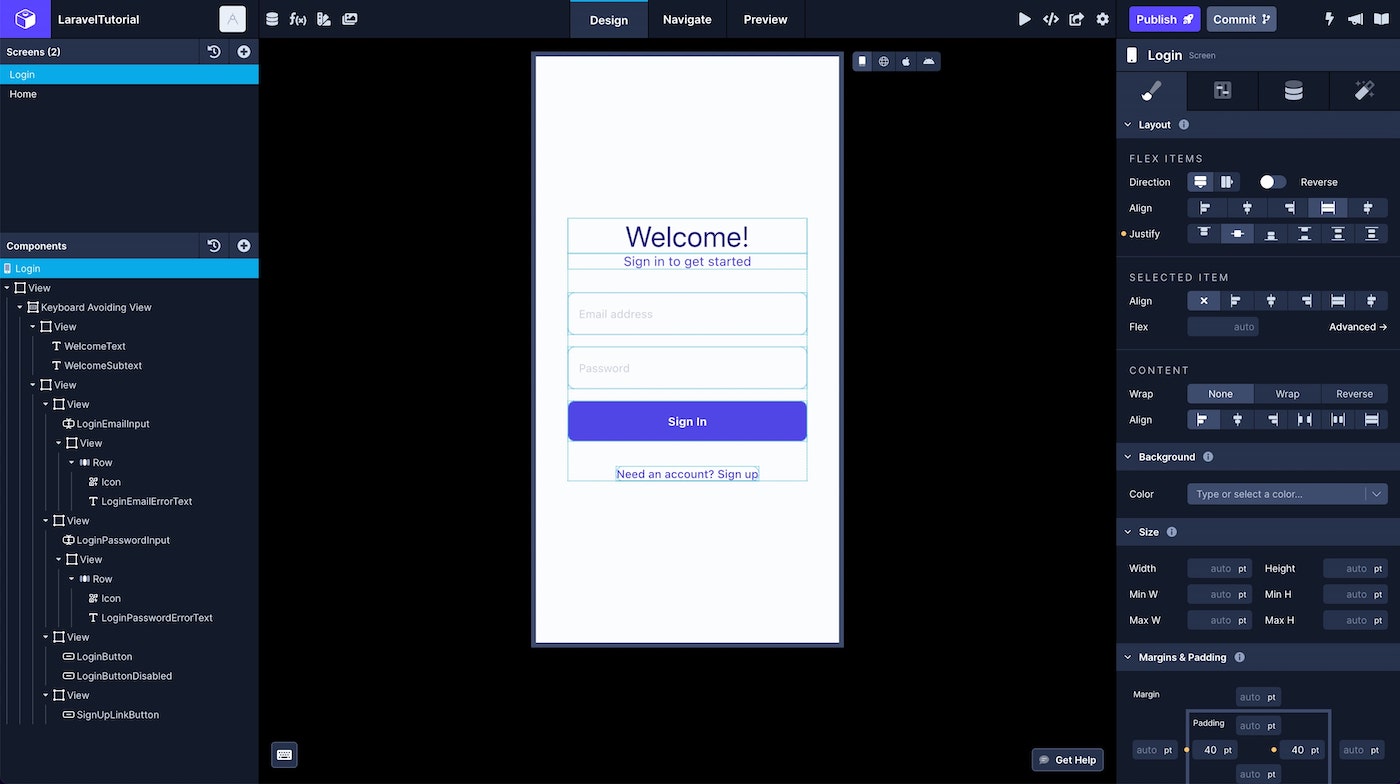
Give your components and fields descriptive names to make working with them and your data easier
Custom Code
Draftbit is able to do some things without writing code, but they also provide a way for you to add your own custom code when you require functionality that doesn't have a built-in Action yet or just want to handle logic via code instead of an Action.
In fact, most of what we're doing here with custom functions can be done using Draftbit's built-in Actions, however I've moved some of that logic to the custom functions we'll be using.
Accessing global variables
In order to get and set the Global Variables we setup earlier, we'll add the following line to our Custom Code Components:
export {useValues, useSetValue} from './config/GlobalVariableContext';Then we need to create a new Inline Code Custom Hook and add the following:
const variables = CustomCode.useValues();
const setVariable = CustomCode.useSetValue();For more detailed information you can checkout this link in the Draftbit docs.
Redirecting an authenticated user
Typically if a user is already authenticated you want to skip the Login screen and send them straight to the Home screen when they open the app.
We can accomplish that by inserting this snippet below the export we previously added to the Inline Code Custom Hook.
if (variables.device_token && variables.device_token != '' && variables.device_token != 'null') {
props.navigation.reset({
index: 0,
routes: [{name: 'AppStack'}]
})
}This code checks to see if we have a device token currently stored in our device_token Device variable. If we do, then we know the user has been authenticated and redirect them to the AppStack.
Here's what my Login screen's Inline Code Custom Hook looks like:
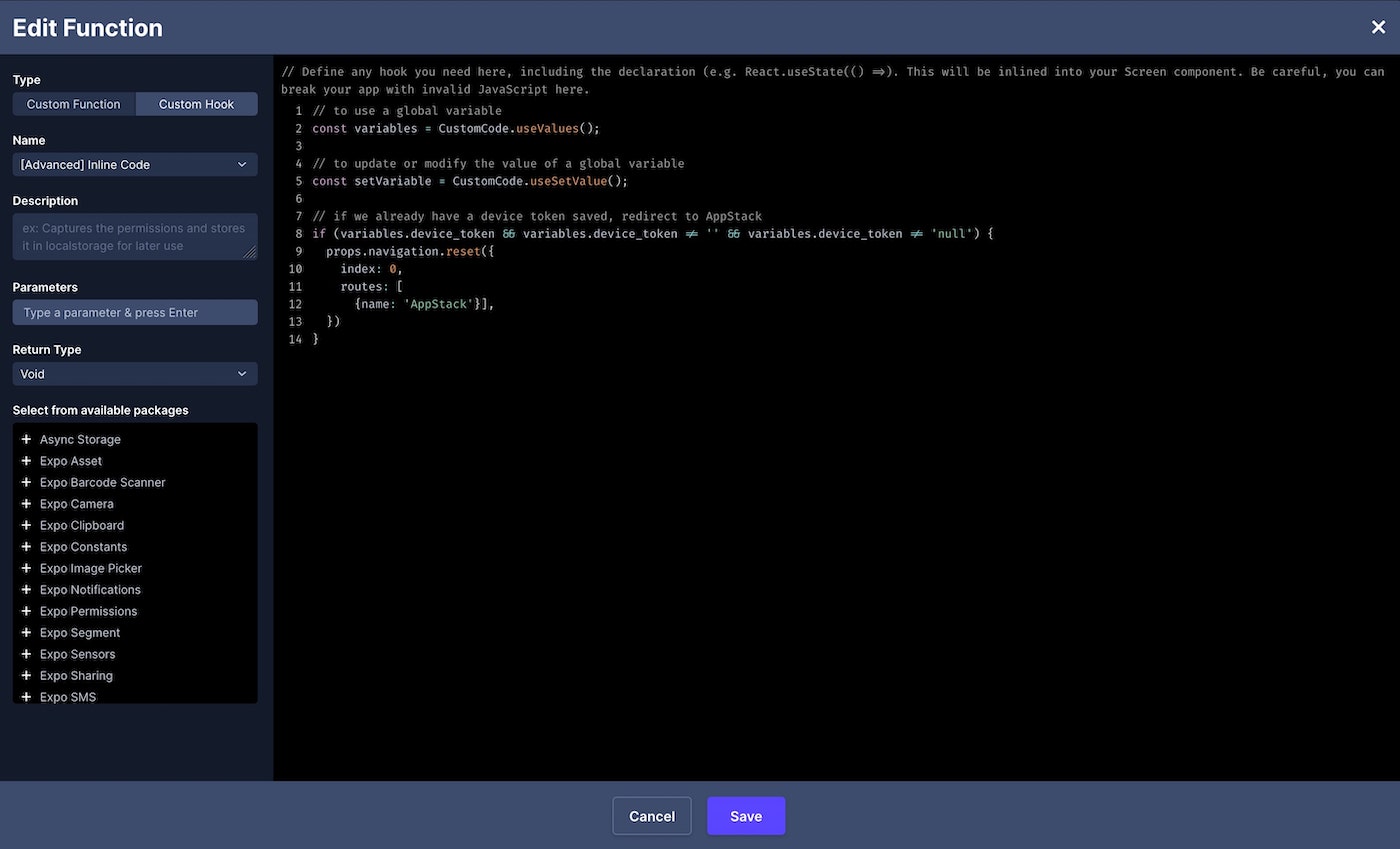
Handling authentication errors
Next we need a custom function to handle the errors we might get back from Laravel when we try to authenticate the user. We can do that by creating a new custom function named handleErrors and passing it a response parameter.
If a field has errors, we'll grab the first one and set it as the value of the associated Screen variable which we'll setup in the next section.
let errors = response.errors
if (errors != null) {
let email_error = 'email' in errors ? errors['email'][0] : null;
let password_error = 'password' in errors ? errors['password'][0] : null;
setEmailError(email_error);
setPasswordError(password_error);
}Clearing authentication errors
In order to clear our error messages, we'll setup a new function named clearErrors and add the following code.
setEmailError(null);
setPasswordError(null);Storing authentication data
When the user's authentication is successful, we'll want to store the user data and device token that we received in the our response. We can do that by creating a new function named setGlobalVariables which receives a response parameter and contains the code below.
setVariable({ key: 'user_id', value: response.id });
setVariable({ key: 'user_name', value: response.name });
setVariable({ key: 'user_email', value: response.email });
setVariable({ key: 'device_token', value: response.token });
setVariable({ key: 'bearer_token', value: `Bearer ${response.token}` });Redirecting after authentication
Once the user has been authenticated we'll then want to redirect the user to our AppStack navigator. To do that let's create a new function named redirectAfterLogin and insert the code below.
props.navigation.reset({
index: 0,
routes: [{name: 'AppStack'}],
})The reset method on the navigation prop removes the AuthStack from our navigation stack so that the user can't go back once they're signed in and replaces it with the AppStack whose initial route is set to the Home screen. You can read more about common navigation methods in their official docs.
Login Button Actions
Actions are built-in functionality which can be assigned to buttons and other touchable components. They can be stacked in order to create a kind of logic flow. We'll use them to authenticate our user.
1. Set Screen State
First, we'll create two screen-level variables for our error messages, emailError and passwordError. You can do this in the Variables modal. These two variables will be updated by our custom code we setup earlier.
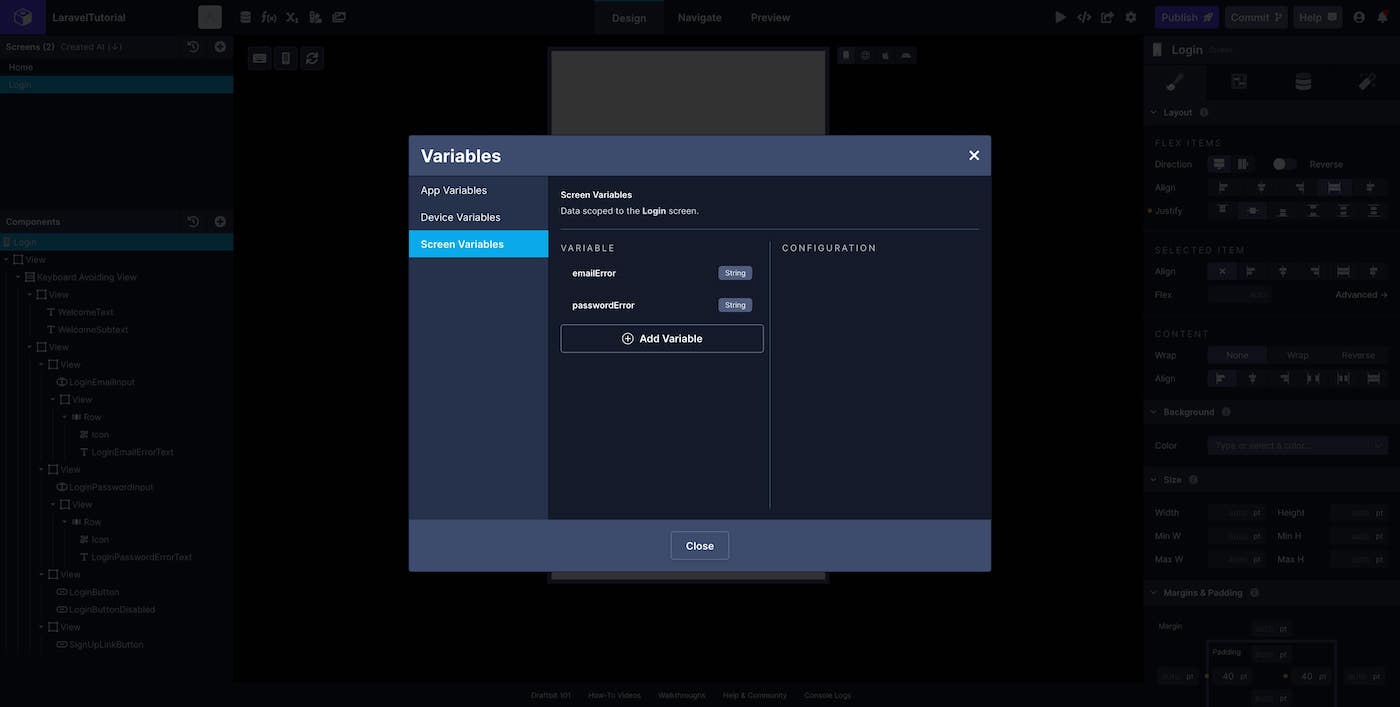
2. Set Variable
First, we'll set the is_loading app variable to true. You can use this to conditionally show components on the screen. I'm using it to determine whether to replace the Login button with another one which is disabled while the API call is being made.

3. Run a Custom Function
Here we will clear any existing error messages using our clearErrors custom function.
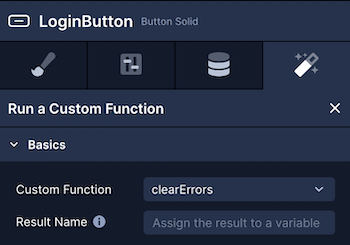
4. API Request
Now we're ready to make the API call to our Laravel application. We can pass the parameters (email, password, device_name) required by our Login endpoint and give the JSON result the name response so we can use it in subsequent Actions.
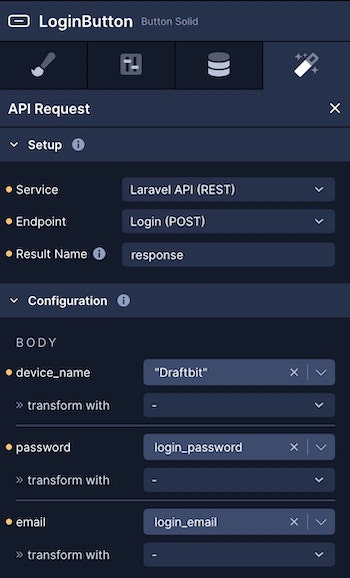
The values you pass as arguments to the request parameters will depend on what you named your email and password input field components
5. Extract Key
If the authentication is successful, the response will have a token attribute which we'll try to extract from the response and assign the result to token.

6. Run a Custom Function
After that, we need to pass the response argument to our handleErrors function.

7. Set Variable
Now that the API call is finished we can update the is_loading app variable to false.
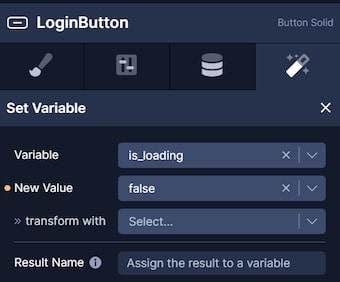
8. Conditional Stop
If our response does not contain a token attribute, we want to stop and only show the error messages. Anything after this Action assumes the authentication was successful.
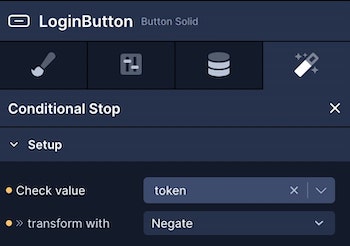
9. Run a Custom Function
Here we'll pass the response argument to our setGlobalVariables function.

10. Run a Custom Function
And, finally, we'll run our redirectAfterLogin function
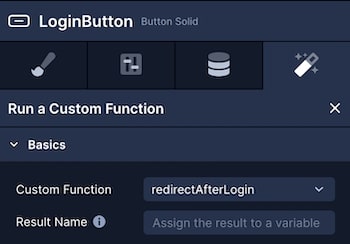
Completed Action Stack
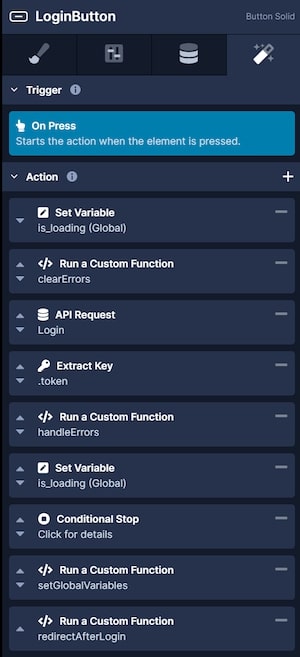
Displaying error messages
When our handleErrors function runs, it sets our emailError and passwordError Screen variables so we can display them on our screen. We can also configure them to only be displayed if an error exists.
Email Error

Password Error
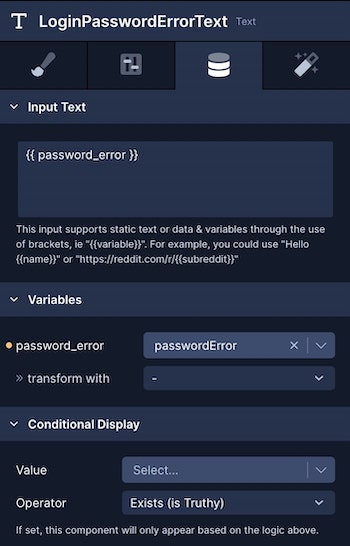
Setup the Home Screen
This screen is just to demonstrate how we can use our Device variables in the UI and also how to logout the user.
Screen Components
We'll use the following 4 components:
- Logout button
- Greeting text (optional)
- Email text (optional)
- Device token text (optional)
Here's what mine looks like:
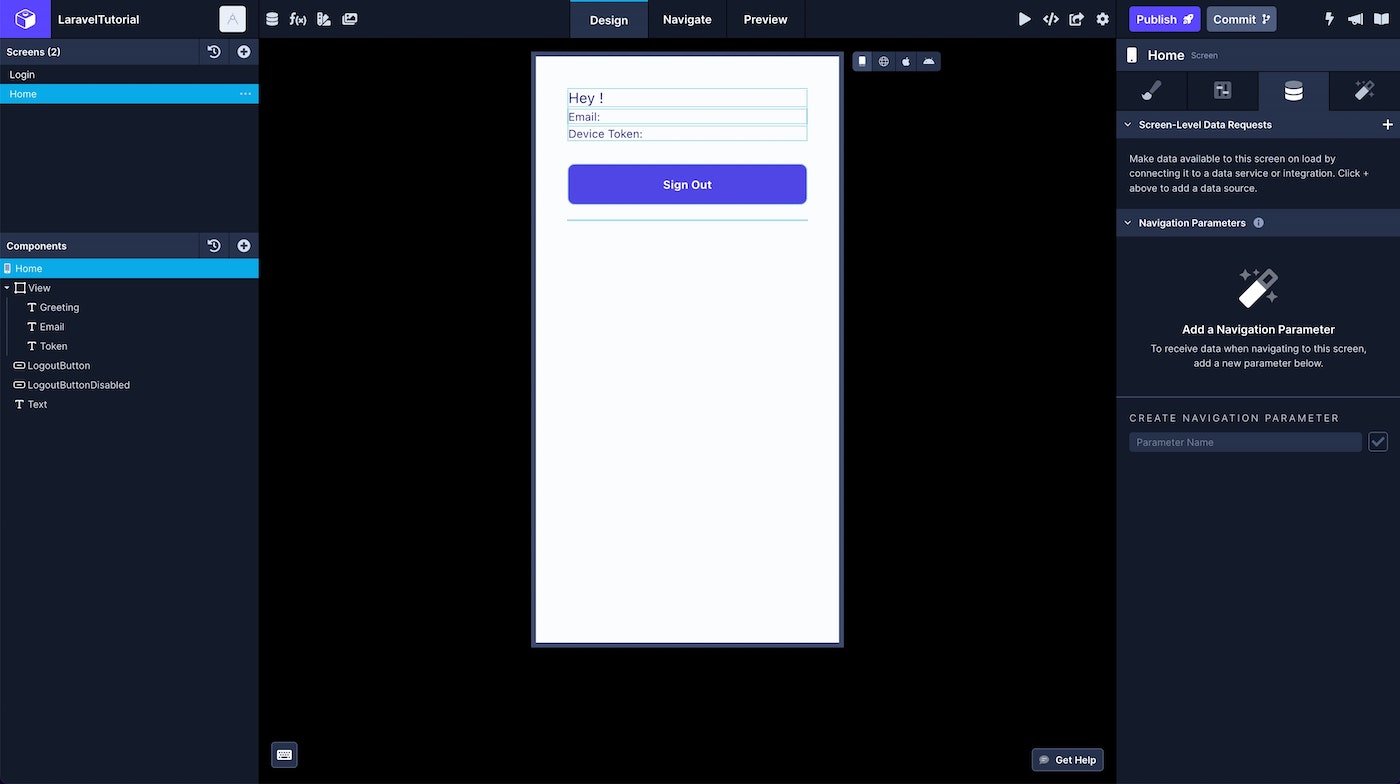
Custom Code
This screen will only require two custom code functions that we'll use to log the user out of our app.
Accessing global variables
Follow the same process we used to make Global variables available to our Login screen. Refer to the docs for more details.
Clearing global variables
First, we're going to create a new custom code function named unsetGlobalVariables with the following code:
setVariable({ key: 'user_id', value: null });
setVariable({ key: 'user_name', value: null });
setVariable({ key: 'user_email', value: null });
setVariable({ key: 'device_token', value: null });
setVariable({ key: 'bearer_token', value: null });
setVariable({ key: 'is_loading', value: false });Redirecting after logout
Last, we'll create a function named redirectAfterLogout which will reset our app's navigator with the AuthStack.
props.navigation.reset({
index: 0,
routes: [
{name: 'AuthStack'}],
})Logout Button Actions
1. Set Variable
Like we did on the Login screen, we'll set our is_loading App variable to true.
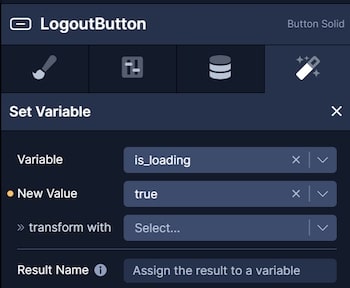
2. API Request
Next we'll make a request to our Logout endpoint, passing it the device_token and user_id Device variables as arguments.
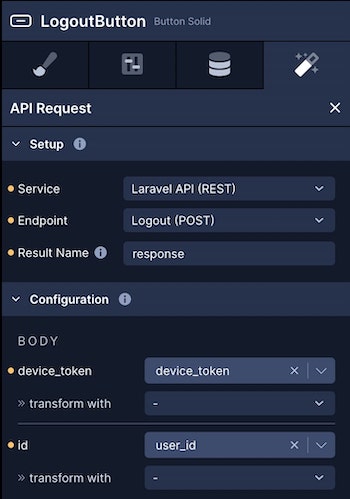
3. Run a Custom Function
Now we can unset all of our global variables using the unsetGlobalVariables function.
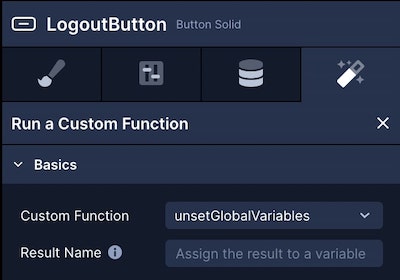
4. Run a Custom Function
And finally, reset the navigator and redirect the user to the AuthStack with our redirectAfterLogout function.
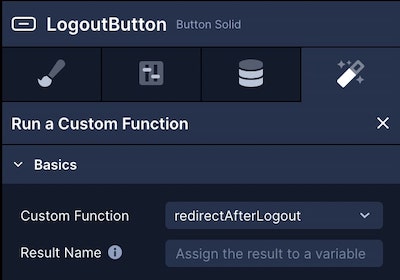
Final Result
Updated about 1 year ago
